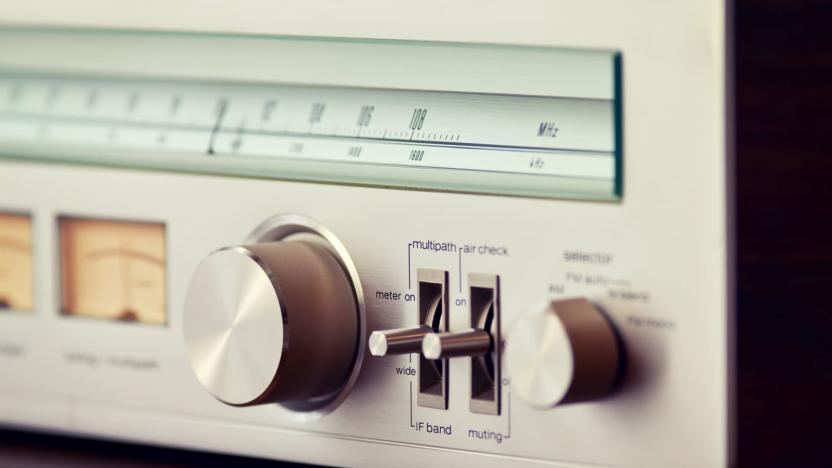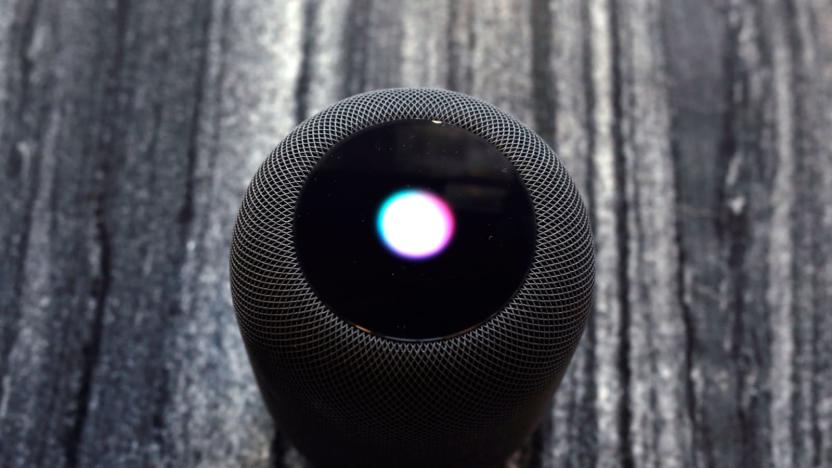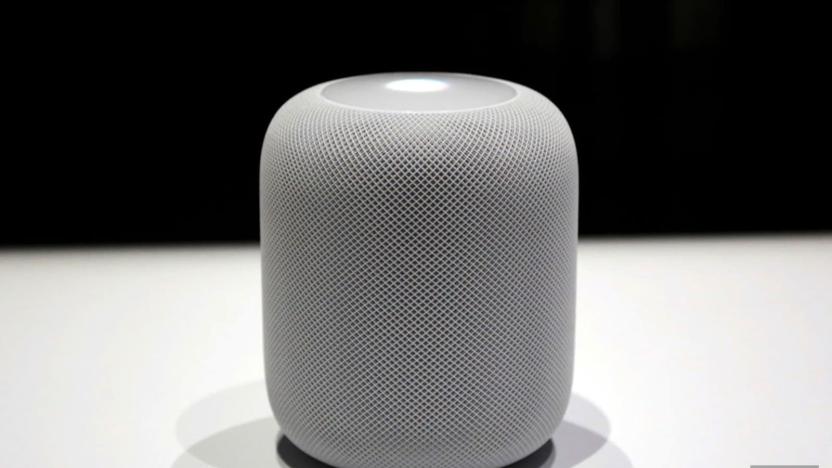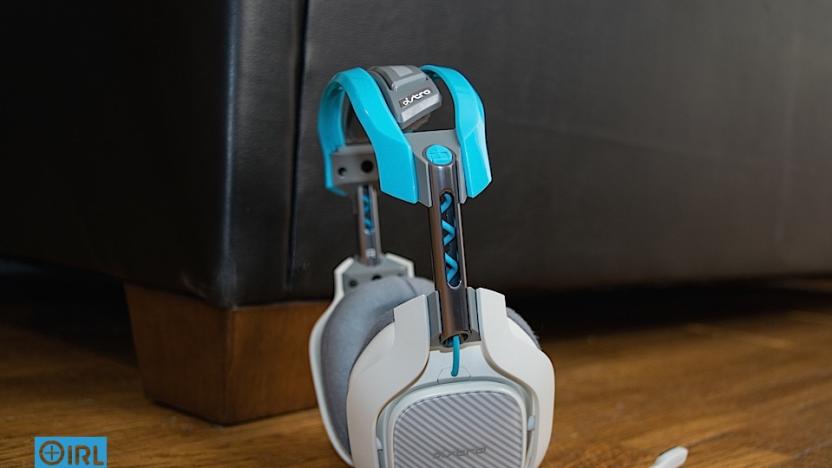stereo
Latest

Oda aren't just speakers, they're a $299 ticket to live music
As such, I’ve been going through what can only be described as live music withdrawal. It’s a pair of speakers where the main selling point isn’t the speakers themselves -- it’s the access they grant to an exclusive subscription of live music and artist “station” takeovers. A three-month season of Oda will cost $79 when the first one starts on December 21st, and that’s in addition to the speakers, which are $299 if you preorder them.

Scientists discover structure within the Sun's atmosphere
While scientists have been learning more and more about our solar system and the way things work, many of our Sun's mechanics still remain a mystery. In advance of the launch of the Parker Solar Probe, which will make contact with the Sun's outer atmosphere, however, scientists are foreshadowing what the spacecraft might see with new discoveries. In a paper published this week in The Astrophysical Journal, scientists detected structures within the Sun's corona, thanks to advanced image processing techniques and algorithms.

What you need to know before building a HiFi system
The process of building a stereo can be overwhelming. Should you buy new gear or trawl the local stereo shop for vintage equipment? Do you need a subwoofer for music? Are high-end speaker cables really going to make a difference in sound? It's no wonder, then, that smart speakers have become so popular: They're available in a variety of sizes and, when paired with a music streaming subscription, are a simple way to access a world of music. But the trade-off for that convenience is sound quality. While an Echo or HomePod is perfect for listening to podcasts, it can't stack up to the power and fidelity you get with a traditional stereo. If you're looking to upgrade, rather than ponying up $500 for a single Google Home Max, consider an alternative solution: building your own stereo HiFi system. While the initial setup and research are more intensive than simply telling Alexa to order more Echo Dots, after it's done you'll have a much more versatile -- not to mention better-sounding -- way to listen to music at home.

Apple's HomePod arrives in Canada, France and Germany this June
Wedged in among Apple's wider iOS 11.4 announcement today comes the news that HomePod is launching in Germany, France and Canada on June 18. This is a significant market expansion, and one surely designed to boost sales of the Siri-powered smart speaker that have so far been rather uninspiring. While Apple hasn't released any official figures, third parties have speculated on disappointing numbers.

iOS 11.4 will add multi-room and stereo audio to the HomePod today
Apple will release iOS 11.4 today, which, with the inclusion of AirPlay 2, brings more functionality to the HomePod. Though other speakers, like the Amazon Echo and Google Home already feature multi-room audio, the HomePod didn't launch with that capability. It also hasn't yet supported stereo pairing. But with today's update, the HomePod now supports both features. Users can sync their HomePods with other AirPlay 2-enabled speakers and play audio throughout multiple rooms. They can also pair two HomePods to create a stereo system. HomePod will launch in Canada, France and Germany on June 18th.

Apple's HomePod won't have multi-room or stereo audio at launch
Apple just announced that its HomePod smart speaker is set to ship February 9th of this year. What didn't make the large print is that it won't support multi-room audio or stereo pairing on that date. These are pretty big features of all other internet-connected speakers these days, which really shows how down to the wire Apple is on getting HomePod into your living room, especially after the recent delay.

Google is reportedly prepping a high-end Home 'Max'
Google Home users looking for a higher-end audio experience may just have their wish. According to a report at 9to5Google, the tech company is currently creating a new version of its smart speaker with stereo sound. It's also presumably larger and will come with a premium price. It's not hard to think of this as Google's response to Apple's HomePod and quality speakers like those from Sonos.

Gamma ray telescope spots ancient, intense black holes
NASA's Fermi gamma ray telescope has been working overtime, it seems. Scientists using the instrument have spotted extreme astronomical phenomenon both at the far edge of the universe and close to home. They've detected the farthest known blazars, or galaxies whose central black holes are so massive (over 1 million times the Sun's mass) that they emit extremely intense light in every spectrum, including gamma rays. The oldest example existed just 1.4 billion years after the Big Bang -- ancient compared to the previous record-setter, which was visible "just" 2.1 billion years after the birth of the universe.

NASA regains contact with spacecraft after a 2-year silence
When mission crews lose contact with a spacecraft or lander for a significant amount of time, that's usually a bad sign... ask the European Space Agency if you want to know why. However, NASA just showed why you shouldn't always give up hope. It reestablished contact with STEREO-B, one of two probes studying the Sun and solar weather, after nearly two years of communications silence. The team had lost its connection during a test of the ship's command lost timer on October 1st, 2014, but kept trying numerous recovery strategies (most recently using the Deep Space Network) until they heard back early on August 21st.

Recommended Reading: The problem with Record Store Day
Recommended Reading highlights the best long-form writing on technology and more in print and on the web. Some weeks, you'll also find short reviews of books that we think are worth your time. We hope you enjoy the read. Record Store Day and the Ambivalent Branding of Independence by Eric Harvey Pitchfork Record Store Day celebrates the culture of independent record shops each spring. Today marks the eighth annual holiday for vinyl collectors and music lovers, but the event is becoming packed with more big names each year. Whether it's Jack White's world record or releases from Metallica or Foo Fighters, celebrities are now just as much a part of the festivities, and distributors seem to be favoring bigger shops over smaller, local spots.

This is how Astro does Xbox One headphones
It wasn't long ago you needed to buy a set of purpose-made cans if you wanted a pair of gaming headphones. Thanks to how the PlayStation 4's and Xbox One's controllers are designed, though, that isn't the case anymore. For Xbox, all you need to use your favorite pair of headphones with Microsoft's latest console is a $35 adapter. So how does a company known for its high-end gaming headsets like Astro compete? With the A40 Xbox One Edition. This $200 headset bests its adversaries, but faces stiff competition from an unexpected place: other Astro headphones.

Porsche offers to put modern tech in the dash of your classic 911
Older sports cars are great for hitting the open road, but let's face it, they lack the bells and whistles of modern automobiles. Porsche is looking to help, though, with a new version of its Radio Navigation System for those older vehicles. On top of turn-by-turn directions, the Bluetooth unit sorts hands-free calls with ports for playing tunes from an SD card, iPod, USB stick or via an auxiliary cable. So if you have a Porsche 911 up to type 993, or a 4- or 8-cylinder that dates back to 1965, you're in luck. Best of all, this new unit sports the overall look of those classic interiors, rather than a modern faceplate from the likes of Pioneer or Alpine. The automaker has offered to outfit older cars with navigation systems before, but this more robust upgrade costs €1,184 (around $1,342). Unfortunately, US pricing and availability hasn't been announced just yet.

Road Warrior Bluetooth speaker plans to amp up your tailgating with 200 watts
If the average portable Bluetooth speaker doesn't pack enough audio punch for your liking, Ion's just revealed a titan that just might meet your needs. Dubbed the Road Warrior, the firm's 200-watt wireless stereo system packs a duo of ten-inch woofers paired with two one-inch tweeters. In addition to Bluetooth streaming capabilities, the box also boasts an AM/FM radio and an 1/8-inch jack. When it comes to power, the package can rely on its built-in battery, a wall plug or the 12 volt outlet in your auto. The kit was designed for occasions like tailgating events and cookouts, so it's fitting that the speakers are contained in a cloth-covered box reminiscent of car audio gear. A price tag and release date are MIA, but expect more information as CES -- and 2014 -- continues.

Sony preps portable and integrated stereo amps for its High Resolution Audio series
Sony began catering to well-off audiophiles last month with its High Resolution Audio series, but it left out portable music fans and those with existing audio systems. The company is covering those gaps in its lineup this weekend. Its new PHA-2 (shown above) is billed as the first portable amplifier/DAC combo to support "virtually every" studio-grade audio format, including 24-bit/192KHz PCM files; it can handle digital audio from PCs and iOS devices, as well as analog audio for other sources. Listeners who are primarily stationary, meanwhile, may want the TA-A1ES integrated stereo amp (seen after the break). The audio companion puts a strong emphasis on reducing unwanted noise through a specially-designed chassis, gain volume control and transistors that minimize sound channel variations. The TA-A1ES is shipping this month for a hefty $1,999, but you'll have to be patient for the PHA-2 -- the portable amp won't arrive until March, when it will cost $600.

Plantronics' $130 Rig gaming headset homes in on the mobile gaming crowd
We've known Plantronics to craft solid PC gaming headsets and now, separate from the GameCom series, its new Rig package aims to appease gamers on every platform. The stereo headset itself features a slim profile with circumarual earcups that fold flat and it connects with two included cables: one features a boom mic, while the other packs an in-line remote and mic for smartphones. The heart of the setup lies within a wired mixer, which'll let you hook up your cellphone, gaming rig (computer or console via USB and Toslink) and the headset simultaneously. Aside from a slider that lets you adjust the balance of game and chat volume (à la Astro's Mixamp), you can answer phone calls and re-route the mic as necessary at the press of a rocker switch. What's more, game audio (including chat) can be mixed into your headset during calls and visa versa via a second balance slider. Lastly, you'll have a choice of three EQ profiles, including a bass boost for extra wubs. Rig will hit retailers in the fall for $130, and we're told future products under the moniker will drop beyond that. Full press release after the break.

Insert Coin: Beacon Audio Blazar Bluetooth speaker brings back Play 360 memories (hands-on)
In Insert Coin, we look at an exciting new tech project that requires funding before it can hit production. If you'd like to pitch a project, please send us a tip with "Insert Coin" as the subject line. We called Beacon Audio's Phoenix "our new favorite portable speaker" just over a year ago. Today, the company's taking to Kickstarter to fund the production of its followup: the Blazar. The speaker features a grown-up design wrapped in aluminum (the Phoenix was plastic), with a softball-sized, cube-esque design. The slightly bulky shape allows for 12 hours of battery life, aside from promising big and clean multi-directional sound thanks to two 50mm drivers and a 65mm bass radiator. Beacon's also loaded the speaker with a microphone, NFC and a dual pairing mode for completely wire-free stereo sound between two units -- like Nokia's Play 360. On top you'll find rubber playback controls, while one side of the unit houses a microUSB input, 3.5mm input and output jacks, power switch and a pairing / mode button. Early-bird pledges of $99 dollars will be available for the first 198 units (split between silver and graphite), followed by an additional 600 priced at $124. Beacon's counting on its artist collaboration editions, however, offering three more colors (500 pieces each) at $134 with Neon Trees, AWOLNATION and Halestorm. If you're up for the risk, Beacon plans to ship all orders by December 1st. Join us past the break for some impressions with pre-release units.%Gallery-194431%

Divoom Onbeat-200 Bluetooth Speaker Review
Divoom, based out of Hong Kong, sells a variety of portable audio devices. Their devices differ in product shape, color, and price, but offer portability, Bluetooth compatibility and rechargeable batteries, which means they're good companions for your iOS devices. I tested the Onbeat-200, one of Divoom's more expensive products, with a US$79.90 list price. First, let's talk about packaging. The Onbeat-200 comes securely packed in a two part plastic box with a handle. The clear top box houses the speaker. A second black box into which the upper box fits includes a small instruction book in seven languages, a Micro to USB charging cable, an auxiliary audio cable, and wrist strap in a resealable zip-lock bag. While all this plastic may not be environmentally sound, I do appreciate that all the pieces fit together in such a way that I can store my OnBeat-200 safely on a shelf with all its pieces. Second, let's look at the form factor. The Onbeat-200 won't win any design awards. It is just a rectangle, covered in some plastic material with a wave design on the sides. While the press release claims it is only 3-inches, the dimensions are actually 6.5" long, 2" wide and 1.5" deep. Available in red, blue, black, or silver (gray), it comes with a user-installable handstrap that seems barely up to the task to carry this one-lb system. The speaker feels heavier though, and I doubt anyone would find the strap comfortable to use. It is too bulky to fit in a pocket, but fine for a purse, backpack, or shoulder bag. Now, let's look at how the speaker functions. The controls for charging and pairing are recessed on one end. A tiny flashing red light next to the mini-USB port indicates when the Onbeat-200 is charging. The light disappears when it is fully charged. It comes back on again as a blue light to signal that the Onbeat-200 is paired to your device of choice. You must use the power switch to turn it off after turning off your iOS device, it does not power off automatically. The volume controls (+ or -) and square stop button sit on the top of the device, as you can see in the product photograph below. The 1200mAh rechargeable battery took surprising little time to charge initially. A full charge should last between six and eight hours. I could not determine how many years the batter might last, nor if it is replaceable. Upon pairing it with my iPhone and engaging a playlist, the speaker came on at full blast. I keep my iPhone volume turned up, because I always use the speaker phone. The volume that exploded out of the Onbeat was ear splitting, not to mention it probably woke everyone in my apartment building. I had to use the iPhone to reduce the volume, because the volume controls did not react fast enough. The minus (-) button did lower the volume once I figured out how hard to press it. When I pressed the plus (+) button to turn up the speaker, it replied with an electronic beep and did absolutely nothing, which I realized meant that the Onbeat was at maximum volume. When I pressed and held the button it skipped to the next song, which it did a few times when I wanted to increase the volume. Thank you very much. I did not have much luck controlling the volume with the button on the top of the speaker, so controlled it with the volume via my iPhone more often than not. Even a small movement of the iPhone's volume yielded a significant difference in volume in the Onbeat-200. The Onbeat-200 showed up twice when I paired it with my iMac. It showed up as Onbeat-20 and Onbeat-20 Stereo. Only the first entry worked correctly. The sound was distinctively more muted and contained more bass tones than my iMac's built-in speakers. I did not find the sound clarity, nor the whole listening experience as good as when it was paired with the iPad or iPhone. I tested my iOS devices outside and that might have made the difference in sound quality. I have a playlist I use just for testing sound products and the Onbeat-200 performed admirably. It sounds best in the mid-range. The bass is full, but songs with deep bass tones rattled a tiny bit. In some tunes it sounded a bit tinny in the higher ranges, especially with heavy harmonica riffs. I was impressed with the range of music it played well. Unfortunately, due to the design, any song which moves from speaker to speaker is lost in the translation. The Onbeat-200 sounds different depending on which side you place in front of you also. One side yields more bass tones than the other. The Onbeat-200 includes a built-in microphone, so it also acts as a speaker phone. This feature worked well, although voices tended to sound deeper than in real life. When the iPhone answers a call, the music automatically pauses, and you switch to the speaker. When the call ends and the iPhone switches back to the music, the device happily complies. You can also end the call with the stop button on the Onbeat-200. The 33-foot listed operating range is a bit generous. I found I started losing my signal at about 23 feet. As mentioned above, it puts out quite a punch at top volume without any distortion. Dvoom recommends that you set your device on any of their stereo speakers to 80% volume. This is probably so that you don't blow the speaker, although they don't mention that tidbit. While I'm not sure it is worth $80, it is does provide good performance and volume while on the go. Do not be mislead by its housing though. Even though it looks rugged and sealed, it is not sand or water-proof. After using it outside, I found bits of grass had weaved themselves into the small holes, so it can easily pick up dirt and sand. If you want volume with little distortion, the Onbeat-200 may fill your needs, but if you want a quality stereo listening experience, I don't think the Onbeat-200 delivers. Specs Weight 540 g (1.19 lbs) (I had it weighed and it was only .99lbs) Output Power: 4 Watts x 2 Total Peak Power: 6 Watts x 2 Driver Size : 2" x 2 Operating Range: Up to 10 meters/33 feet Bluetooth Compliant V2.1 +EDR Bluetooth profile support A2DP Stereo Signal-to-noise: 75dB Charging Voltage: USB or AC/DC wall adaptor 5V

Panasonic thinks you'll pay $1,200 for a home stereo with neon subwoofers
Of note, that thing you see above cannot be copped for $20 at your local Thrift Shop.

UE Boom: a splash-resistant, Bluetooth-enabled speaker for overzealous rioters
You know what'll go perfectly with that waterproof Bluetooth speaker ball that a Billy Corgan doppelganger recommended a few years back? That odd tube you're undoubtedly fixated on above. That's the Ultimate Ears UE Boom, and those people underneath are presumably blitzed from a day of raving at [insert EDM festival here]. Parent company Logitech is calling this thing the "world's first social music player," but last we checked, it's not capable of tweeting whatever you're listening to. Instead, it's seemingly engineered "to help you rage, riot, party and play the music you love, out loud." Seriously -- that's in the description. In order to do so, there's a Bluetooth radio within, NFC support, a 15-hour rechargeable battery and an exterior that'll turn away light splashes. Of note, you can wirelessly link two UE Booms together using an associated Android or iOS app to play them in either stereo-to-stereo mode or traditional left / right stereo mode. It's expected to hit US and European shores later this month for $199.99, which means you too can take weird shots of yourself holding it at frat parties in the very, very near future.

Zoom iQ5 professional stereo microphone hands-on
Earlier at CES, we got our hands on the Rode iXY 30-pin stereo microphone iPhone add-on that left our Lightning users a bit sad. Cheer up! The folks over at Zoom got us over to their booth to take a peek at the company's new iQ5 professional stereo microphone. The iQ5 is a different beast than its aforementioned competition in that it works in conjunction with native iOS applications. What this means is that you can use it while recording video on your iOS device. The microphone itself rotates for this specific purpose, allowing for both horizontal and vertical audio recording in raw, 90- and 120-degree field positions. The recording resolution is capped at a respectable 16-bit/44.1kHz -- though slightly less than we were hoping. We didn't get a chance to actually hear an audio sample from the iQ5, but we're pretty confident it'll sound better than the standard mic equipped on any of the supported devices. The Zoom iQ5 lacks a bit in customization department as well as build quality -- we're generally not fans of the cheap plastic construction, which is unlike most other Zoom products. The spec sheet certainly leaves us wanting, but it's a start in the right direction for current-gen iOS devices. The iQ5 will set you back $100 and will start shipping Q2 of this year -- until then check out the gallery to hold you over.











